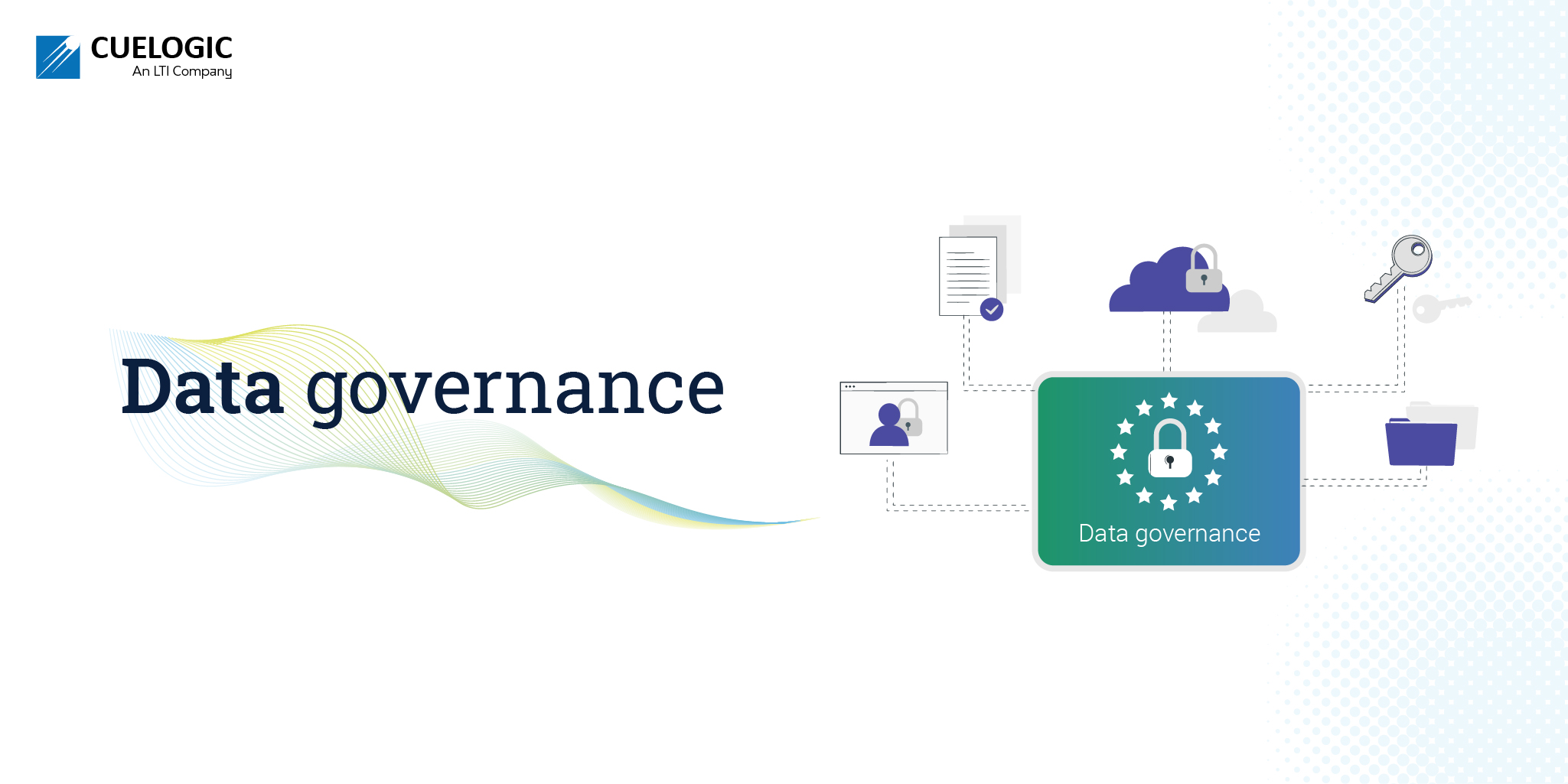For a few years now, the consumer experience across virtually every industry – retail, healthcare, travel – has changed.
The change can be attributed, in large part, to the relatively recent overhaul of the technological landscape. At the heart of this digital revolution lies data. So when companies compete to provide better experiences to their customers, they have to leverage data to get maximal insights.
The increased attention on data across industries means that there needs to be improved control around data; this is where data governance comes in.
What is Data Governance?
Data governance refers to organisations’ standard policies and procedures to ensure that data is appropriately handled. Data governance defines a strategy for which users can take what action, upon what data, in which situations, using what methods.
What Does Data Governance Include?
Data governance encompasses every stage of the data life cycle, from data input to storage, manipulation, access and deletion.
It includes the responsibilities of establishing appropriate infrastructure and technology for handling data, maintaining processes and policies, identifying the roles that need to have authority over safeguarding data.
The Significance of Data Governance:
A data governance strategy is fundamental in every organization that works with data to help ensure that data is usable, accessible and protected. Data governance has the benefit of leading to improved data quality, reduced data management costs, and improved access to data for all stakeholders. This results in data-driven decision making and improved business results.
The fundamental purpose of data governance is to supply definite answers to how a company can gain from the benefits of data while minimising the risks of poorly handled data.
How can Data Governance be Business-Oriented?
A well-defined data governance strategy is now considered crucial for all organisations. It brings all the stakeholders on the same page to define how operational efficiency and business revenue can be improved.
For businesses, data governance can be used in several ways:
1. Operational Business Intelligence (BI)
Operational BI helps organisations identify areas where their operational flows create a bottleneck for optimal performance.
2. Dashboards with Market Trends
Market trend dashboards help business leaders understand new focus areas for business growth, opening up potential new avenues for revenue.
3. Proactive Monitoring of Data Compliance
Monitoring compliance is critical to the daily operations of an organisation with large amounts of data. Compliance breaches can lead to irreversible reputational damage.
4. Increased Understanding of Organizational Data
Homogenizing data across the organization helps accelerate digital transformation by giving a greater understanding of the relationship between data elements.
5. Cost Reductions
Resources are saved due to the lesser need for data maintenance as data quality is improved implicitly with a suitable data governance strategy.
Goals of Data Governance
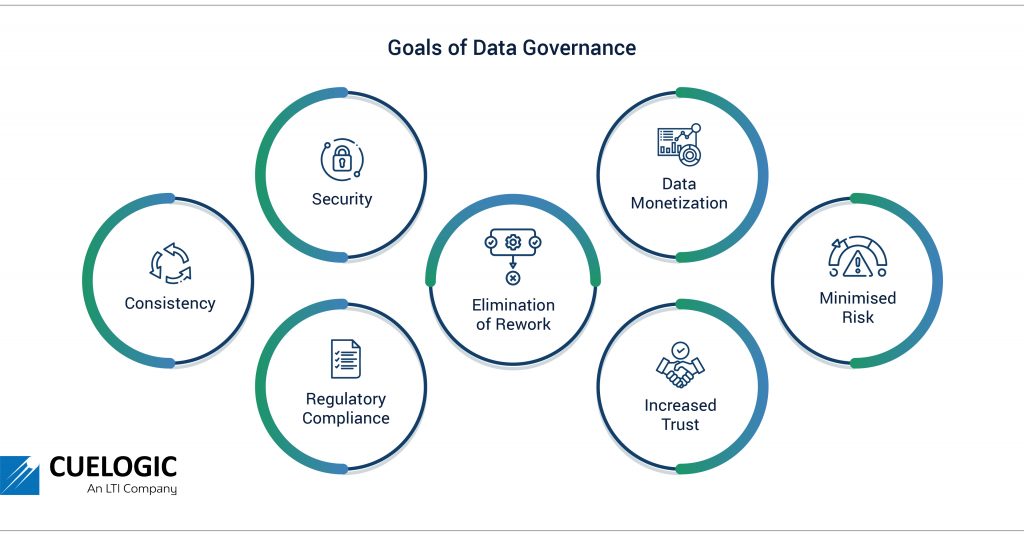
When designing a data governance plan, organisations need to prioritise their particular organisational goals. The following list encompasses the goals that data governance can help a company achieve:
1. Consistency
Data consistency means that all users see a consistent view of the data. For applications with distributed databases, data consistency is critical to implement correctly.
2. Security
Data security ensures that data is neither corrupted nor accessed by unauthorized parties. For robust data security, organizations need to include practices like data encryption at rest and in transit, key management policies, authorization policies and more.
3. Regulatory Compliance
The number and complexity of data regulations that organisations need to follow have increased significantly. Authorities monitor how data is stored and used. There are also penalties levied if companies act irresponsibly or unethically. Hence regulatory compliance is one of the most critical goals of data governance.
4. Data Monetization
Leveraging data optimally can help businesses improve their profit/loss ratio. There are three main data monetization strategies: collecting user data to pass onto other services, improving products and services with user data analytics, or improving operational processes by gaining insights from data. Data governance helps organizations choose the right strategy as per their priorities and organize their data in a manner which can easily be monetized for their domain.
5. Elimination of Rework
Having a standard data model applied across all enterprise data helps organizations save on resource time that would otherwise be needed for data homogenization. In addition, organizations that invest in storing data in a canonical format can better leverage their data rather than being handicapped by the need to consolidate data before it can give insights.
6. Increased Trust
With growing awareness among customers, customers now demand to know how their data is used. Having good customer service thus includes ensuring customers of more transparent data management practices, which can be achieved with effective data governance.
7. Minimized Risk
Data governance helps minimize risk by establishing a framework for evaluating adherence to policies. Monitoring and alerting tools also help to notify teams of any breach in data management policies.
Setting up a Data Governance Team:
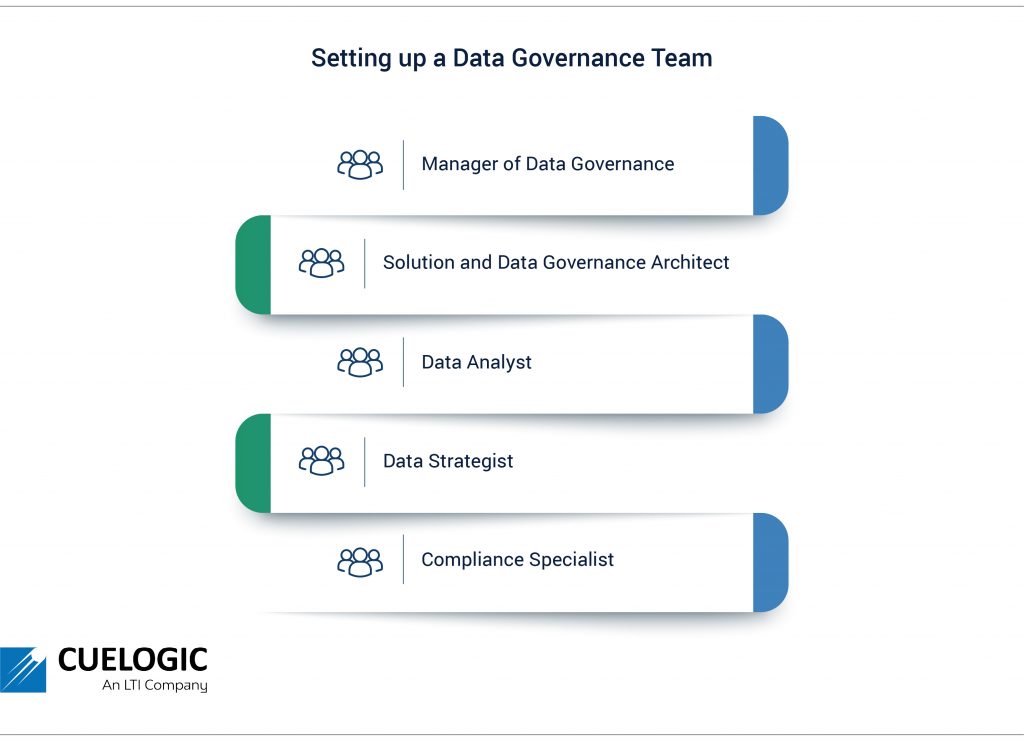
Data governance is a broad topic at the enterprise scale that needs a dedicated team to ensure it is executed effectively. The team needs to include specialists from every aspect of data governance. Hence, a sound data governance team needs to have members for the following positions:
1. Manager of Data Governance
The team manager ensures that the data governance priorities stay aligned with organizational strategies. The manager is also in charge of auditing the various data governance practices across the organization.
2. Solution and Data Governance Architect
The architect is the person who will bring in experience and expertise about different technological options that the team has and which will be optimum for the organization.
3. Data Analyst
The data analyst is the person who understands the structure of the data and can help build visualizations and design solutions for critical business insights. This is the contact person when there is the need to extract a specific data type.
4. Data Strategist
The data strategist is the person who defines how data for new applications can be designed to keep it aligned with existing data models. In addition, he ensures that the database is designed in a manner that makes it easy to drive business strategies.
5. Compliance Specialist
Every data governance team needs a specialist to ensure that data quality matches regulatory requirements. The specialist keeps in touch with laws regarding data maintenance, which can differ per country, region and even domain.
Apart from these positions, the Data Governance Team also needs to constantly touch with business stakeholders to ensure they stay aligned with organizational priorities. Again, involving team members in the process can lead to better outcomes.
The Components of a Data Governance Strategy:
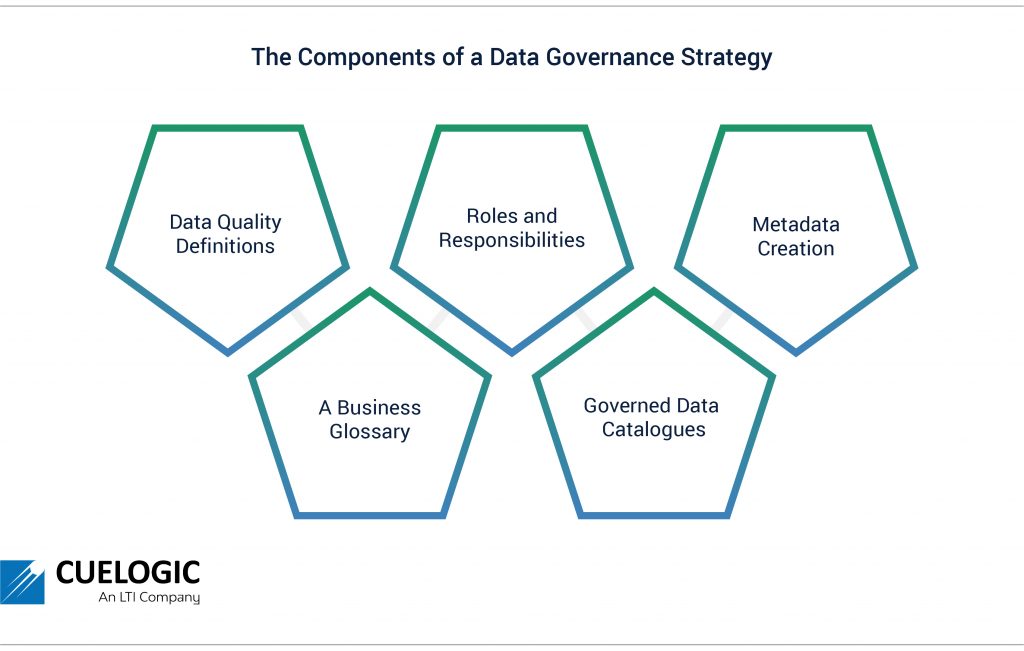
A data governance strategy tends to remain theoretical until it includes a few tangible components:
1. Data Quality Definitions
This metric helps determine the organization’s expectations and need for data quality. For instance, a bookselling company may have a lower tolerance for data quality than a chemical manufacturing company.
2. A Business Glossary
A shared glossary across the organization helps to record the meaning of all data, ensuring clarity and that a standard schema is used for the same data fields across the organization.
3. Roles and Responsibilities
It is imperative to have a dedicated team set up which maintains the policies around data.
4. Governed Data Catalogues
Data catalogues help teams to understand the origin of the various data points. In addition, catalogues can group data into related collections based on how previous users accessed the data, providing additional meaning and insight.
5. Metadata Creation
Metadata helps track the relationships among data, such as data with similar meanings, data used by similar business processes, data specific to departments, and so on.
Apart from these tangible components to a data governance strategy, it is also essential to teach the culture of active participation from company employees. This allows users to indicate when data is incorrect, promoting better quality data and building trust in the data.
6. Data Legislation
Each country has its own set of judicial legislation at the governmental level that determines data governance for various domains. Governments are increasingly introducing industry standards for consumer privacy assurance and tighter security measures for digital payments. In addition, national governments have recommendations for issues of anonymity and on state surveillance.
Apart from this, governments also mandate the stringent reporting of data breaches. Furthermore, hardware manufacturers also have to comply with judicial regulations. To keep up with the changing norms, organisations need to ensure a well-versed compliance specialist on their team.
Data Governance Tools
Every organization that implements data governance policies needs to use tools to achieve the task. There are various options in the data governance sector to choose from. However, while making a choice, a few features must be kept in mind. The tool should have the ability to:
1. Capture and Understand Data
By making use of profiling, and benchmarking tools and capabilities. For instance, the right tools should automatically detect a piece of personal data, like a social security number, in a new data set and mask that data before displaying its value to the system user.
2. Improve the Quality of Data
The tool should have data validation, data cleansing, and data enrichment features.
3. Manage Data
By integrating with other ETL (Extract, Transform, Load) tools and data integration pipelines, the tools should be able to support an end to end management of data from various sources.
4. Review and Monitor Data
The tools should have capabilities for data visualisations and alerting mechanisms in case of any breaches, as defined by the surveillance team.
5. Ability to Store Document Metadata
Metadata helps increase the relevance, searchability, accessibility, and compliance of data. This enables the use and re-use of data appropriately.
6. Empower People
By being easy to use, with defined functions for data stewardship, people can be empowered to leverage the data to the best of its potential.
Challenges in Data Governance
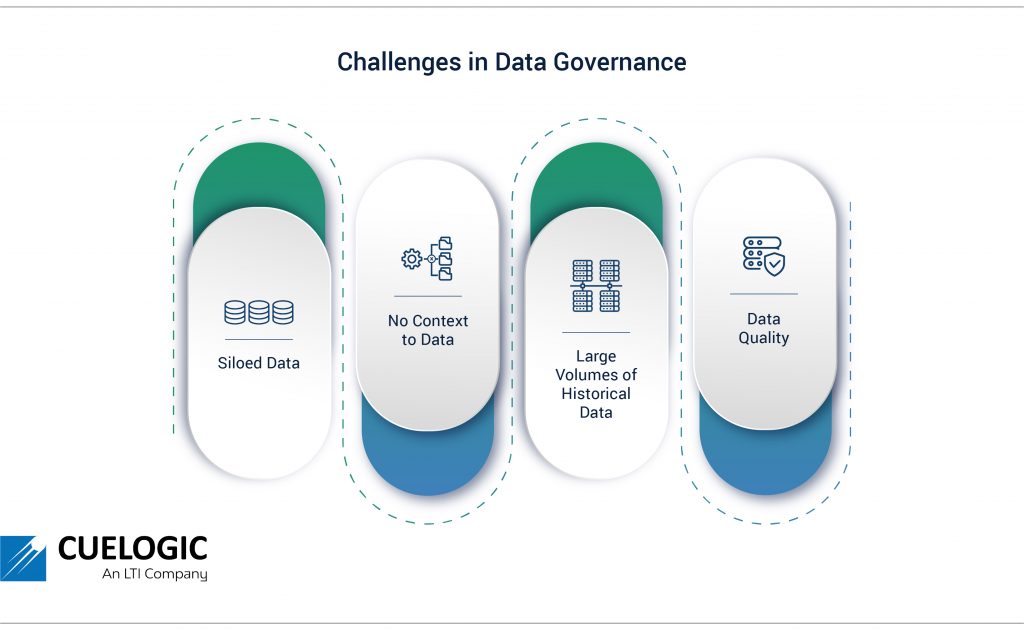
As data volume increases exponentially, so too does the number of challenges in data governance. As a result, there are challenges regarding data governance that arise within the company and externally.
Some of the common challenges in data governance can be listed as below:
1. Siloed Data
Data silos, also called information silos, refer to information stored in different systems that are not interconnected. Siloed data makes collaboration across teams difficult, leading to inconsistency in data quality, a lack of visibility, and higher data maintenance costs over time. Data siloed cannot be leveraged to its fullest potential, and efforts need to be put in to consolidate the data before it can give real business insights.
2. No Context to Data
Metadata defines context to data. It includes details like how often a particular dataset is accessed, by which team, during what periods, and so on. This metadata provides crucial context for other users. It can help to flag compliance areas if, for instance, a dataset contains sensitive data and needs enhanced security measures. If this context, or metadata, is missing, businesses need to put in a lot of effort to determine each dataset’s significance and usage patterns.
3. Large Volumes of Historical Data
Organizations with massive amount of historical data need to preserve it and face challenges while implementing data governance strategies. They need to consolidate all their data onto a common platform, which can be a challenge owing to the volumes and various specific formats of stored data and specific security regulations that the data may have.
4. Data Quality
One of the most significant challenges in data governance comes from errors that arise due to inaccuracies, data that is no longer valid, and data that is missing completeness.
Best Practices in Data Governance
Effective data governance can bring immense value to an organisation if implemented well.
However, certain guidelines should be followed for data governance to be implemented successfully:
- Introduce homogeneity in tools used across the organization, keeping systems as simple as possible. By making the governance process simple, it is more likely that the organization will drive the data governance strategy further to derive business benefit from it.
- Incorporate a peer review process to ensure that data is consistent and accurate. Develop guidelines that outline how to do things at each organizational level so that governance is inculcated as a part of the culture across the organization
- Have a clear and comprehensive access management system in place. This is one of the basic steps in maintaining the security of data.
- Keep business stakeholders engaged. This helps the data governance plan get adopted across the entire organization.
- Use metrics to measure progress. It is essential to keep a close eye on your governance strategy. Businesses should be able to derive tangible benefits from their data governance strategies.
- Encourage communication across the organization. It is vital to ensure ongoing communication to all the stakeholders about the current status of governance practices across the organization.
- Conduct training and education for all relevant teams, individuals, and stakeholders so that the data governance culture stays relevant.
- Start with easily achievable goals and build up from there. Since data governance can be a mammoth task, small initial plans help organizations get started on the path.
Conclusion
Organizations have vast amounts of data about their customers, suppliers and employees. Data governance ensures that this data can be trusted, maintained and used efficiently. This information can then be leveraged to better help businesses gain success. Thus, it can be said that data governance can no longer be considered optional for any enterprise.
